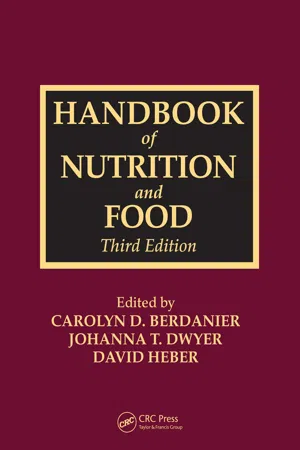
Handbook of Nutrition and Food
- 1,136 pages
- English
- PDF
- Available on iOS & Android
Handbook of Nutrition and Food
About this book
The new edition of the Handbook of Nutrition and Food follows the format of the bestselling earlier editions, providing a reference guide for many of the issues on health and well being that are affected by nutrition. Completely revised, the third edition contains 20 new chapters, 50 percent new figures. A comprehensive resource, this book is a reference guide for many of the issues on health and well being that are affected by nutrition. Divided into five parts, the sections cover food, including its composition, constituents, labeling, and analysis; nutrition as a science, covering basic terminology, nutritional biochemistry, nutrition and genetics, food intake regulation, and micronutrients; nutrient needs throughout the human life cycle; assessment of nutrient intake adequacy; and clinical nutrition, from assessments to a wide variety of disease and health topics.
Frequently asked questions
- Essential is ideal for learners and professionals who enjoy exploring a wide range of subjects. Access the Essential Library with 800,000+ trusted titles and best-sellers across business, personal growth, and the humanities. Includes unlimited reading time and Standard Read Aloud voice.
- Complete: Perfect for advanced learners and researchers needing full, unrestricted access. Unlock 1.4M+ books across hundreds of subjects, including academic and specialized titles. The Complete Plan also includes advanced features like Premium Read Aloud and Research Assistant.
Please note we cannot support devices running on iOS 13 and Android 7 or earlier. Learn more about using the app.
Information
Table of contents
- Front Cover
- Appreciation
- Contents
- Preface
- Editors
- Contributors
- Chapter 1 - Food Composition
- Chapter 2 - Food Constituents
- Chapter 3 - Microbiological Safety of Foods
- Chapter 4 - Safe Food Handling for the Consumer
- Chapter 5 - Food Labeling: Foods and Dietary Supplements
- Chapter 6 - A Primer on Food Law
- Chapter 7 - Computerized Nutrient Analysis Systems
- Chapter 8 - Food Intake Regulation
- Chapter 9 - Nutrition and Genetics
- Chapter 10 - Nutrition Terminology
- Chapter 11 - Nutritional Biochemistry
- Chapter 12 - Macromineral Nutrition
- Chapter 13 - Trace Mineral Deficiencies
- Chapter 14 - Vitamin Deficiencies
- Chapter 15 - Nutrient Interactions
- Chapter 16 - Finding Mouse Models of Human Disease for Use in Nutrition Research
- Chapter 17 - Nutrient Needs of Man and Animals
- Chapter 18 - Nutrition during Pregnancy and Lactation
- Chapter 19 - Feeding the Premature Infant
- Chapter 20 - Nutrition for Healthy Children and Adolescents Ages 2–18 Years
- Chapter 21 - Healthy Diet through Adulthood*
- Chapter 22 - Nutrition in the Later Years
- Chapter 23 - Exercise and Nutrient Needs
- Chapter 24 - Nutrient Needs of the Elite Athlete
- Chapter 25 - Food and Nutrition for Space Flight
- Chapter 26 - Vegetarian Diets in Health Promotion and Disease Prevention
- Chapter 27 - Dietary Guidelines, Food Guidance, and Dietary Quality in the United States
- Chapter 28 - Dietary Guidelines around the World: Regional Similarities and Differences and New Innovations
- Chapter 29 - Nutrition Monitoring in the United States
- Chapter 30 - Nutrition Monitoring and Research Studies: Observational Studies
- Chapter 31 - Nutritional Screen Monitoring Tools
- Chapter 32 - Dietary Intake Assessment: Methods for Adults
- Chapter 33 - Use of Food Frequency Questionnaires in Minority Populations
- Chapter 34 - Methodologies and Tools for Dietary Intake Assessment
- Chapter 35 - Validity and Reliability of Dietary Assessment in School-Age Children
- Chapter 36 - Anthropometric Assessment: Stature, Weight, and Body Mass Index (Adults)
- Chapter 37 - The “How” and “Why” of Body Composition Assessment (Adults)
- Chapter 38 - Height, Weight, and Body Mass Index in Childhood
- Chapter 39 - Frame Size, Circumferences, and Skinfolds
- Chapter 40 - Psychological Assessment for Adults and Children
- Chapter 41 - Energy Assessment: Physical Activity
- Chapter 42 - Environmental Challenges and Assessment
- Chapter 43 - Oral Health Screening and Assessment for Nutrition Professionals
- Chapter 44 - Herbal Supplements in the Prevention and Treatment of Cancer
- Chapter 45 - Nutritional Assessment in the Clinical Setting
- Chapter 46 - Metabolic Syndrome, Overweight, and Fatty Liver
- Chapter 47 - The Malnourished Child
- Chapter 48 - Childhood Obesity
- Chapter 49 - Eating Disorders
- Chapter 50 - Food Addiction and Obesity
- Chapter 51 - Nutrition and Liver Disease
- Chapter 52 - Food Allergy and Food Intolerance
- Chapter 53 - Nutrition and Immune Function
- Chapter 54 - Nutrition and Dental Health
- Chapter 55 - Protein Nutrition, Meal Timing, and Muscle Health
- Chapter 56 - Micronutrient and Macronutrient Supplementation
- Chapter 57 - Bioactive Substances and Botanical Dietary Supplements
- Chapter 58 - Nutrition and Diabetes
- Chapter 59 - Nutrition in Renal Disease and Hypertension
- Chapter 60 - Diet–Gene Interactions
- Chapter 61 - Diet, Nutrition, and the Prevention of Cardiovascular Disease
- Chapter 62 - Nutrition and the Gastrointestinal Tract
- Chapter 63 - Nutritional Management of the Bariatric Surgery Patient
- Chapter 64 - Dietary Factors Related to Frailty and Reduced Functional Capacity
- Chapter 65 - Enteral and Parenteral Nutrition
- Chapter 66 - Mechanisms Accounting for the Cancer Protective Effects of Bioactive Dietary Components in Fruits and Vegetables
- Chapter 67 - Nutrition and Cancer Treatment
- Chapter 68 - Nutrition and Age-Related Eye Diseases
- Chapter 69 - Nutrition and Brain Health
- Chapter 70 - Nutrition and the Skin
- Chapter 71 - Nutrition and Skeletal Health
- Chapter 72 - Drug Interactions with Nutrients and Natural Products: Mechanisms and Clinical Importance
- Chapter 73 - Drugs Used in the Treatment or Management of Human Diseases
- Chapter 74 - Directory of Clinical Nutrition Websites
- Back Cover